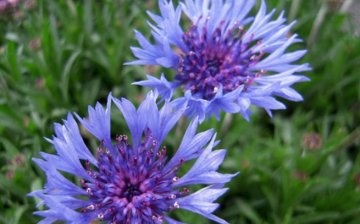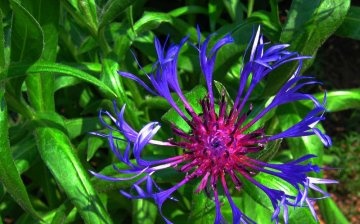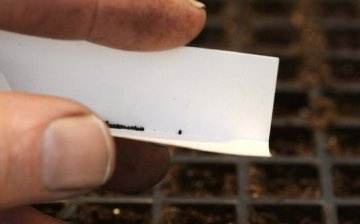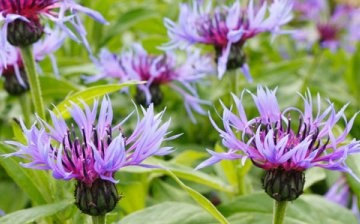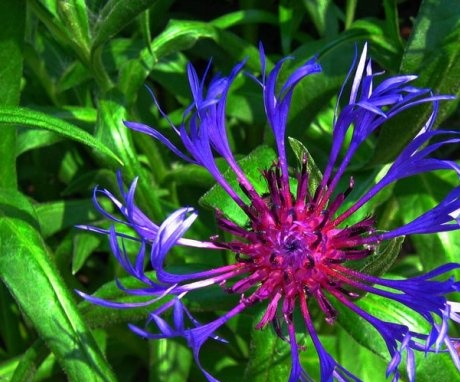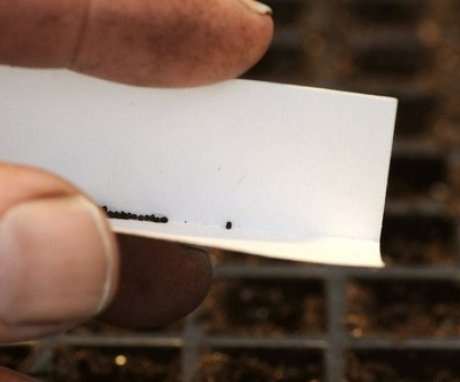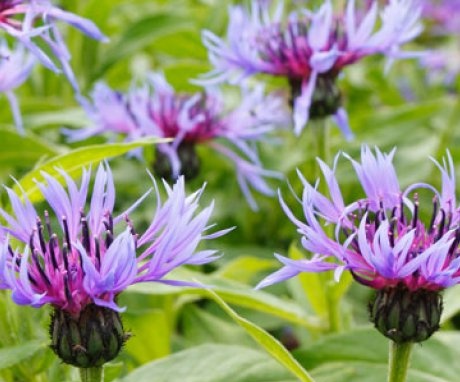Mountain cornflower is a beautiful and unpretentious perennial in your area
cornflower Is a fairly well-known flower. This genus has 500 species. One of the most common is the Mountain Cornflower (Centaurea montana).
Content
Cornflower mountain: description
Mountain cornflower is a perennial plant with erect shoots topped with single flowers with a diameter of 6-8.5 cm. If you look closely, it is easy to see the structure of the inflorescence in them. This is a basket, along the edges of which there are large funnel-shaped, and inside are small tubular flowers. They are "wrapped" from below in a wrapping of several rows of fringed leaves.
The mountain cornflower blooms for about 2 months, starting in June.
Varieties:
- Alba, a short plant with white flowers.
- Parham (purple).
- Grandiflora with blue flowers up to 8 cm in diameter.
- Rosea has pink flowers.
- Violetta with deep purple flowers.
The birthplace of the mountain cornflower is the Western European mountains. Therefore, it is adapted to unfavorable conditions. The scorching sun and strong wind are not terrible for this plant. A branched root, dropping into the soil to a depth of 10 cm, helps to hold firmly in the ground.It is formed in a horizontal plane and grows by 5-6 cm per year.
The mountain cornflower is prized for its beautiful flowers and decorative whole leaves with a white edge.
They grow intensively in the spring. By the end of summer, they gradually fall off, but the plant does not lose its attractiveness. Instead of fallen leaves, new ones grow, which turn green until next spring.
Uses of mountain cornflower:
- In the form of curtains (separate groups).
- For the design of rockeries (areas using stones).
- In mixborders (mixed elongated flower beds).
- To create rock gardens.
- Cut flowers stand in a vase for a long time.
- Freshly opened flowers can be dried by hanging in a place protected from sunlight and used in winter bouquets.
Growing
The mountain cornflower is not very picky about the soil, but it grows better on fertile loamy soils. Can tolerate minor drought, but does not like stagnant water. Therefore, the soil must be drained. You can add chopped bark of deciduous trees, garden compost. Better to do it a couple of months before landing... The growing scheme is 50 x 50 cm. With this planting scheme, the bushes do not close each other and are well lit. Mountain cornflower tolerates frost in winter (freezes in the middle lane) and sun in summer. And he does not like shadows, loses its decorative effect there.
Therefore, it must be planted in sunny areas.
Cornflower mountain refers to plants that do not require special leaving... He is hardly surprised pests and diseases... But he can suffer from a fungal disease fusarium. Leaves wilt and turn pale for no apparent reason. This happens if the cornflower grows on acidic or slightly acidic soils. To prevent this from happening, you need to maintain the acidity level of pH 7-8 (neutral or slightly alkaline).
Growing on the site speaks of neutral and weak acidity of the soil clover, field bindweed, chamomile... Wild poppy grows on alkaline. If the soil is too acidic (the area grows horsetail, plantain), add slaked lime or wood ash to it. If you follow these simple rules, the mountain cornflower will grow in one place for 7-10 years.
Reproduction
Like most perennial flowers, mountain cornflower reproduces by dividing the bush and seeds... After flowering an egg-shaped seed capsule is formed. Seeds are small, in 1 g of them up to 300 pieces. They are harvested at the end of summer. But they do not sow right away, because during this period there is usually a drought, and they will not germinate. Seeds do not lose their germination for 3 years.
In order for them to sprout, they are sown before winter (October-November) or in the spring, in April-May, to a permanent place.
Sow scattered, lightly sprinkle with earth and watered. Seeds germinate at normal humidity in a week and a half. If the seedlings are thickened, they are broken through, leaving a distance of at least 20 cm.
It is easier to propagate a mountain cornflower by dividing a bush or by root suckers:
- Most often this is done in the spring, but it can also be done in August, after flowering.
- The bush that will be used for propagation is dug up.
- Root system washed.
- The bush is cut into pieces, each of which must have at least three buds (growth points) and a root.
- Prepare the soil. Garden compost, rotted manure are brought in, the earth is dug up and the harvested cuttings are planted.
- The roots are directed to the sides and down. It is not worth deepening much.
- The soil around the plant is pressed so that all voids are filled.
- Water regularly until the plant grows.
- You can mulch the soil around the plants with crushed bark. It will give the site a decorative look and retain moisture in the soil.
Seed propagation is a little more troublesome than dividing the bush... But both will bloom next year. Therefore, reproduction by seeds is justified if there is no way to get the cut.
Mountain cornflower care
The mountain cornflower is quite high, 40-60 cm.Therefore, it is usually placed in the background or in the center flower beds... Scourge with flowers can be tied. In dry weather, the area where the mountain cornflower grows is watered. This also applies to seed emergence. After all, they need watering more than adult plants. After the flowers have lost their decorativeness, they can be cut along with the peduncles above the branch. This will facilitate the abundant formation of new buds. Do not remove them if you plan to collect seeds.
In order for the plant to bloom as long as possible, feed with a complex mineral fertilizer.
A tablespoon of nitrophoska and urea is diluted in a bucket of water and watered before flowering. In the fall, they are fed already so that the plant overwinters well.
To prevent fusarium, all parts of the plant are sprinkled with wood ash. Sometimes rusty spots appear on the leaves of mountain cornflower. This happens when moisture gets in during watering. Such leaves are removed. Usually mountain cornflower does not require much leaving... It is enough to periodically weed the soil until the leaves merge into a solid carpet. The mountain cornflower is sometimes called the flower for lazy gardeners. Even minimal maintenance can provide excellent results. The main thing is to successfully place the plant in the garden so that the bright flowers are clearly visible.
More information can be found in the video.




